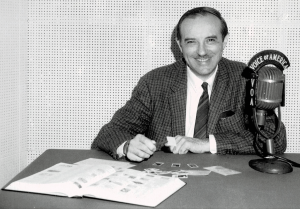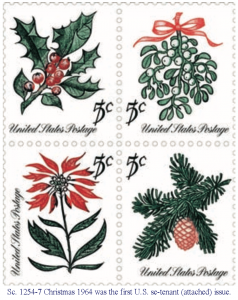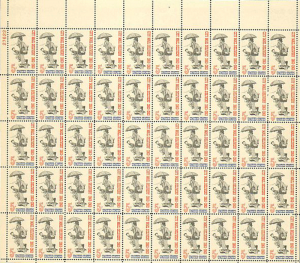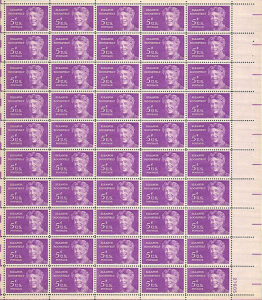Mint U.S.: The Gift That Keeps on Giving (at a Reduced Rate)
By John M. Hotchner
My father, gone nearly 30 years, would be stunned if he knew how his “investment” turned  out. He was among those stamp collectors who, coming out of World War II, surveyed the value of U.S. new issues of the 1920s and 1930s, and thought “Hmmm…Mint U.S. commemorative stamps are popular, and the retail value seems to go up. So, I’ll buy a couple of sheets of every new issue, and when little Johnny gets to be college age, there is a little nest egg.”
out. He was among those stamp collectors who, coming out of World War II, surveyed the value of U.S. new issues of the 1920s and 1930s, and thought “Hmmm…Mint U.S. commemorative stamps are popular, and the retail value seems to go up. So, I’ll buy a couple of sheets of every new issue, and when little Johnny gets to be college age, there is a little nest egg.”
[Above, Howard Hotchner in 1943, when he was working for the Voice of America (Office of War Information). And, yes, with part of his collection.]
He was assiduous in making sure every new issue was represented in his mint sheet files, and many regular issues, Air Mails, and other stamps too. Fortunately, he was wise in that  he bought only what he could afford, and what he could afford to lose; because when it came time to sell in the early 1960s, the market for sheets of U.S. commemoratives had tanked.
he bought only what he could afford, and what he could afford to lose; because when it came time to sell in the early 1960s, the market for sheets of U.S. commemoratives had tanked.
There were many reasons; not least among them the fact that the Post Office Department anticipated the new demand, and began to issue two to four times the number of stamps for each issue as compared to the pre-1940s issues. They also ratcheted up the number of issues per year to previously undreamed of totals. And in the 1950s, the basic First Class rate began to creep up.
 So, when all the little Johnnies and Janies got to college age in the late ‘50s and early ‘60s, the tens (if not hundreds) of thousands who had the same idea went to the well to collect on their investments, and found that there was far more supply than demand. If they could get 75% of face for routine stamps and full face for plate blocks, they were doing very well. Crank in the reduced purchasing power of the dollar, thanks to inflation, and even the realizations received were not nearly high enough to cover the initial outlay.
So, when all the little Johnnies and Janies got to college age in the late ‘50s and early ‘60s, the tens (if not hundreds) of thousands who had the same idea went to the well to collect on their investments, and found that there was far more supply than demand. If they could get 75% of face for routine stamps and full face for plate blocks, they were doing very well. Crank in the reduced purchasing power of the dollar, thanks to inflation, and even the realizations received were not nearly high enough to cover the initial outlay.
As the number of collectors has dropped, and the First Class postage rate has increased, the value of quantities of U.S. post-WWII mint stamps has continued to fall. Who wants to buy 3¢ commemoratives when it takes 18 of them (plus 1¢) to pay the current First Class rate?
And yet, habits are hard to break. Having begun to buy sheets, my father couldn’t bring himself to stop. Even when he knew that his expectations for the earlier purchases had not panned out, he kept right on buying; almost to the day he went into a nursing home with Parkinson’s Disease and a broken hip.
It isn’t uniformly true that all modern era U.S. stamps have only scrap value. Some limited  printings that have topical value — such as Space-related, some sports heroes, the first stamps of a continuing series (such as Black Heritage) — still bring a modest premium. Also, some booklet panes, line pairs, plate number coils, and souvenir sheets. But for the vast majority of post WWII stamps, people selling them in quantity are now able to realize a mere 50-60% of face. And even some booth-holders at stamp shows who used to offer sheets of stamps to collectors for face value, are now forced to undercut their prior pricing in order to remain competitive.
printings that have topical value — such as Space-related, some sports heroes, the first stamps of a continuing series (such as Black Heritage) — still bring a modest premium. Also, some booklet panes, line pairs, plate number coils, and souvenir sheets. But for the vast majority of post WWII stamps, people selling them in quantity are now able to realize a mere 50-60% of face. And even some booth-holders at stamp shows who used to offer sheets of stamps to collectors for face value, are now forced to undercut their prior pricing in order to remain competitive.
 Now, don’t expect this dynamic to hold for single stamps being sold to collectors. Dealers who retail modern- era U.S. singles have to do more than buy and sell in large quantities. Even if they buy cheap, they have to break up sheets, put single stamps in glassines or make up year sets, advertise by individual Scott numbers, provide storage space for what is pending sale, and haul their wares to wherever they retail; or pay commissions if they are selling online using established websites. It all takes an investment of time and space, in addition to the investment of money. So you will pay more than face for single stamps to complete your album pages.
Now, don’t expect this dynamic to hold for single stamps being sold to collectors. Dealers who retail modern- era U.S. singles have to do more than buy and sell in large quantities. Even if they buy cheap, they have to break up sheets, put single stamps in glassines or make up year sets, advertise by individual Scott numbers, provide storage space for what is pending sale, and haul their wares to wherever they retail; or pay commissions if they are selling online using established websites. It all takes an investment of time and space, in addition to the investment of money. So you will pay more than face for single stamps to complete your album pages.
And the beauty of the stamps, and the joy of completing pages makes the modest outlay worthwhile. But realists know that you will not be able to sell these stamps for what you paid for them.
 The holder of quantities of U.S. mint, often in my experience survivors of the original purchaser, rarely have a clue that what they have is not so much windfall as white elephant. I can’t count the number of times I’ve had to explain to the new owners the facts of philatelic life; that they have only a few alternatives:
The holder of quantities of U.S. mint, often in my experience survivors of the original purchaser, rarely have a clue that what they have is not so much windfall as white elephant. I can’t count the number of times I’ve had to explain to the new owners the facts of philatelic life; that they have only a few alternatives:
- Use most of what they have as postage for the relatively few letters and packages that they send.
- Share the stamps with family members to do the same.
- Take up stamp collecting themselves.
- Sell to a dealer at the prevailing (reduced) rate, or to friends and neighbors at 25% off.
- Donate them to a 501c3 charitable organization for the tax benefit.
- Or if you can find one, donate to a school or youth stamp club.
The saving grace for some is that they are not desperate for the money; and they understand that their collector enjoyed his or her collecting activities, and even reveled in the acquisition of new issues and understanding the story behind each new stamp; even if their dreams of profits could not be realized. My father was in this class. He was a passionate collector who often got out a magnifying glass to study the design of each new stamp. While I think he would be surprised by how low the market has gone, I doubt he would be losing any sleep over it!




Tell John that this article should be in Linn’s – it needs wider distribution. I’m also going to bookmark this page and use it in the future when confronted with the same scenario.
I would go to my downtown post office in the early 1960s and there would be folks buying 3 or 5 sheets of stamps for their investments.
my father was a life long stamp collector and purchased full sheets . of new issues faithfuly. As time went on postal rates increased and the numbers of new issues dramatically increased each year becoming more costly for collectors. My father finially quit. The USPO policy of NOT selling partial sheets or individual stamps did not help in this situation. The philatelic community contributes a considerable income to the post office and should be catered to. for this reason.
In the great, late philatelic writer Herman Herst Jr.’s book The Compleat Philatelist (1979) of which I read a 2nd time this year, mentions, and warns of saving many full sheets of postage stamps, but as in this article, Herst also neglects to point out that album page-makers such as H.E. Harris began putting images of multi-block subjects both in block form AND singles form. I believe this started with the 1972 Cape Hatteras 2c issue (Scott # 1448-52) You can look at a Scotts U.S. Specialized catalog (as I’m looking at now) and see the progress of more stamps issued to where the page-makers added single images in addition to the block images. I (and I’m sure many other collectors) did not realize the need for TWO sets of an issue needed to fill spaces until such time as those pages went on sale, usually about a year later. Initially, some issues sold out quickly at local post offices e.g. the Boston Tea Party stamps of of 1973 (Scott # 1480-83) because collectors caught on that they now needed 2 sets to fill album pages. As rumors had it back then, it would be a “good investment” to buy sheets of these stamps, because later on the buyer is thinking he will discover folks at his local stamp club were “unaware of the need” for 2 sets. (More likely, they too bought extra sheets thinking the same thing as you were thinking!) I still have some of those “extra sheets” I use on outgoing mail, but generally, I was not one of those interested in hoarding sheets of stamps. My budget at the time would not allow it anyway!
good story, my father inlaw fell into the same problem. some 4 shoe boxes of 3 centers and after he passed i finally sold them to a firm out west all plate blocks in glassine envelopes. i assume used for postage. about 30 years ago.
Hi John,
Thanks for this very good article, Loved it!
My wife and kids think that one day they can just sell my collection for absolute ten’s of thousands of dollars, to many thousands of people who “Must” want it!
because that’s what I have spent over 40 years!
I live in Australia and the cost to get a $11 Booklet pane this years costs me $22 Australian dollars, by the time they add postage, taxes and then the awful difference between US and Aussie Dollar, currently 66c to US Dollar, but no matter what it costs, it’s my hobby that I have loved every day of my life, and nothing can convince me that it’s a bad investment!
Regards
Peter